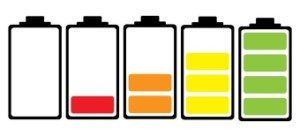“Jim is probably going to freak out if I disagree with him, and I’m ok with that.”
“Miriam delivers, when I give her a job to do.”
“I know Yuri will do the right thing.”
Those are all statements of “trust”.
You trust that they still truly care about you, even when you disagree with them. You trust their ability to complete the task that they committed to. You trust that they will adhere to the same set of principles you do.
When you feel someone else is trustworthy, you become willing to take risks and be honest with that person. You can show vulnerability because you feel confident that she or he will not take advantage of you.
Like many things that can be challenging to quantify, e.g., trust, a metaphor can come in handy. I love a good metaphor.
The “Trust Battery”
 Tobias Luke, CEO at Shopify, coined the term, ‘trust battery’, in a New York Times interview. “Another concept we talk a lot about is something called a trust battery. It’s charged at 50 percent when people are first hired. And then every time you work with some at the company, the trust battery between the two of you is either charged or discharged, based on things like whether you deliver on what you promise.”
Tobias Luke, CEO at Shopify, coined the term, ‘trust battery’, in a New York Times interview. “Another concept we talk a lot about is something called a trust battery. It’s charged at 50 percent when people are first hired. And then every time you work with some at the company, the trust battery between the two of you is either charged or discharged, based on things like whether you deliver on what you promise.”
Luke sees the trust battery as a summation of all interactions to date. “If you want to recharge the battery, you have to do different things in the future. Only new actions and new attitudes count…
Further, “a low trust battery is at the core of many personal disputes at work. It powers stressful encounters and anxious moments. When the battery is drained, everything is wrong, everything is judged harshly. A 10 percent charge equals a 90 percent chance an interaction will go south.”
For the most part, I agree with Luke. I defer somewhat on “only new actions and new attitudes count”. Rather, what’s most valuable is that the interactions be positive. Positive interactions charge up a battery.
The positively charged trust battery energizes your workplace relationships.
Build trust, one interaction at a time
Trust is earned, one interaction at a time.
When your trust battery is fully charged with positive interactions, the current is strong, and the quality of your interactions and relationship is healthy.
On the flip side, when your trust battery is low on charge, the current is weak, and the quality of your interactions and relationship is fragile. Don’t let your battery die.
Now, of course, every time you use a battery you are drawing current, you are lowering the charge of that battery. The trick is keeping the battery fully charged, or close to fully charge. A fully charged battery makes whatever its’ being used for, work. And, that includes your interpersonal relationship.
The Magic Relationship Ratio – aka, how to keep the trust battery fully charged
We are wired to pay attention to the negative. Think of the news you read, today, your social media feed… Negative interactions grab our attention. However, they suck for building trust, and healthy relationships. Negative interactions impact us way more than positive. For building trust and healthy relationships, whether at home, in the workplace, or the community, accentuate the positive.
Each of our daily interactions with another person is what relationship expert John Gottman calls a “bid for connection”. By choosing to turn toward, to turn away, or turn against each other’s bid for connection – no matter how ordinary or small – we establish a foundation that could determine the future success or failure of our relationship. Good relationships usually develop slowly over time, growing out of the many mundane interactions we share each day. Building trust in a relationship doesn’t require gut-wrenching conversations that plumb the depths of our souls. (‘Bid for connection’ is my number one maxim, in Collaborative Maxims: Principles for Working Together.)
So, what is the optimal ratio of positive bids versus negative bids? The Magic Relationship Ratio?
Gottman’s longitudinal research shows 5:1 (positive vs negative interactions) is required to sustain a marriage relationship. As a parent, I recall 3:1 as the magic ratio for praising vs. disciplining young children. In the workplace, somewhere from 3 to 5: 1 is appropriate? What’s your experience?
Bid positively. It charges your trust batteries. It strengthens your relationships. And, the quality of our relationships determines the quality of our lives.
A note about trust in teams
When it comes to teams, an additional construct, related to trust, is helpful: psychological safety.
Psychological safety relates to a person’s perspective on how threatening or rewarding it is to take interpersonal risks at work. For instance, is this a place where new ideas are welcomed and built upon? Or picked apart and ridiculed? Will my team members embarrass or punish me for offering a different point of view, or for admitting I don’t understand something?
Author, professor, and thought leader on psychological safety, Amy Edmondson says “although trust and psychological safety have a lot in common, they are not completely interchangeable concepts. A key difference is that psychological safety is thought to be experienced at the group level most people on a team tend to have the same perceptions of it. Trust usually relates to interactions between two individuals or parties.”
Either way – trust or psychological safety – keep those batteries charged, keep those relationships energized, with a surplus of positive interactions.


Speak Your Mind